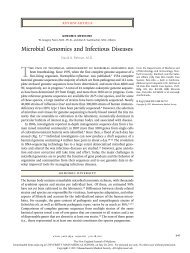A Scalable Peer-to-Peer Network for Virtual Environments - Evernote
A Scalable Peer-to-Peer Network for Virtual Environments - Evernote
A Scalable Peer-to-Peer Network for Virtual Environments - Evernote
Create successful ePaper yourself
Turn your PDF publications into a flip-book with our unique Google optimized e-Paper software.
diagram of all AOI neighbors and directly connects them <strong>to</strong> minimize latency. As only<br />
a few neighbors are kept, the cost <strong>to</strong> maintain a Voronoi diagram at each node is low.<br />
To prevent overlay partition (i.e. groups of nodes become mutually unaware of each<br />
other), we also require each node <strong>to</strong> minimally keep its enclosing neighbors (which<br />
may be outside the AOI when neighboring nodes are sparse).<br />
When a node moves, position updates are sent <strong>to</strong> all connected neighbors (i.e.<br />
AOI neighbors plus any enclosing neighbors beyond AOI). Neighbor discovery is via<br />
notifications from boundary neighbors, as they know both the moving node and other<br />
nodes beyond the AOI (which happen <strong>to</strong> be their enclosing neighbors). This way,<br />
potential AOI neighbors are discovered with mutual collaborations. As a node moves<br />
around, it will constantly discover new nodes and disconnect those that have left its<br />
AOI (unless they are enclosing neighbors). A node thus restricts communications with<br />
mostly the actual AOI neighbors, independent of the scale of the system. Keeping<br />
bandwidth consumption at each node bounded -*+$C7+D7(+$%+234)*+*.'?'E-?-$(F<br />
3.3 Dynamic AOI adjustment<br />
One potential concern is that when crowding occurs (i.e. user gatherings that<br />
cause high densities of nodes, see the center of Fig. 2a), nodes are <strong>for</strong>ced <strong>to</strong> connect<br />
beyond their capacities. Oliveira and Georganas introduced the notion of dynamically<br />
adjustable AOI [20], so that nodes with different bandwidths can individually<br />
determine their optimal AOI-radii. We also apply dynamic AOI adjustments with<br />
three simple rules: 1) a node shrinks its AOI when the number of connected neighbors<br />
exceeds a pre-specified connection limit; 2) AOI res<strong>to</strong>res <strong>to</strong> the preferred size if the<br />
number of connected neighbors again falls below the limit. 3) To ensure mutual<br />
awareness between nodes, a node will not disconnect a neighbor whose AOI still<br />
covers it, even if that neighbor is outside of its own AOI.<br />
!!
















